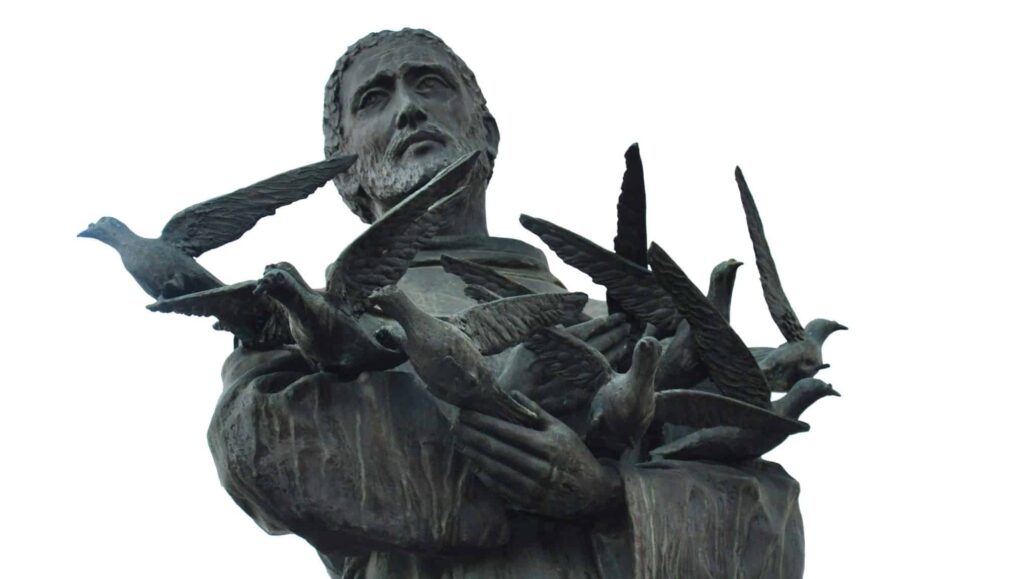The mysticism of St. Francis grew out of and was not separate from his sacramental and gospel life. Francis’ intimacy with God was not a category of experience separate from his intense living of the gospel within the church.
True, at the beginning, when he was still “in the world,” as he put it, he was gifted with ecstatic dreams and with the vision of Christ speaking to him from the crucifix of San Damiano and with the vision of Christ the Leper. But even then Francis did not have these visions and dreams in order to draw him into himself but to draw him into the mystery of the church. “Go and rebuild my house,” the voice of the crucifix spoke, “which, as you see, is falling utterly to ruin.” Francis went out and begged for stones to repair the ramshackle chapel of San Damiano, and eventually the house of the larger church itself. And when he saw Christ in a leper, Francis went to live among the lepers.
“[A]nd the Lord Himself led me among them,” Francis writes in his Testament, “and I worked mercy with them.”
The visitations from the Lord led Francis into church-building and church-making together with others, not into self-absorption. In the same way, the inner conversions he experienced and his lifelong walking in the footsteps of the poor Christ derived from his response to the Gospel on two occasions, especially, in February and April of 1208.
The first occasion was the Gospel Reading on the Feast of St. Matthias, February 24. After Mass Francis, who’d been moved by the reading, asked the priest to explain the gospel to him, which the priest did, line by line. When he heard the words that Christ’s true disciples should “Take no gold, or silver, or copper in their belts, no bag for your journey, or two tunics, or sandals, or a staff” (Matthew 10:9–10), Francis was filled with joy and cried out, “This is what I want; this is what I desire with all my heart!” Francis began immediately to live out Christ’s words.
This is Francis the practical mystic, one who responded wholeheartedly to God’s Word and in that response God was revealed. Everyone can be this kind of mystic with God’s grace. The practical mystic is not one with secret knowledge of God, but one who knows God in doing the will of God.
God’s Will
Francis expands on this practical mysticism for everyone when he writes in his “Letter to the Faithful.”
We are his bride when our faithful soul is united with Jesus Christ
by the Holy Spirit; we are his brothers and sisters when we do
the will of his Father who is in heaven, and we are mother to him
when we carry him in our hearts and souls through love and a
pure and sincere conscience, and give him birth by doing good.
This is a mysticism for everyone. This is a mysticism Francis offers to all believers, a mysticism that he illustrates through the gestures of his own life. The Franciscan mystic is the ordinary Christian mystic who is brother, sister, bride and mother of Christ by means of a fidelity, made possible by the Holy Spirit, in doing God’s will, in carrying Christ within and through love and a pure and sincere conscience and in giving birth to Christ by the charity of good works. In all of this is intimacy with God, and an intimacy with God that results in charity is practical mysticism.
It is interesting that Francis’ response takes place within a liturgical setting and that he seeks the explanation of the priest before he acts on God’s Word. His personal response to the Gospel had begun, and it was precipitated by hearing the Gospel read at Mass.
In the same year, Francis was approached by the son of a wealthy nobleman of Assisi, Bernard of Quintavalle, about how Bernard might “reject the world” after the example of Francis, who answered that they needed to seek God’s counsel. The two then went to the church of St. Nicholas in Assisi, and after they’d prayed, Francis opened the Missal three times to discern God’s will.
The first text to appear was: “If you wish to be perfect, go, sell your possessions, and give the money to the poor” (Matthew 19:21). The second read: “Take nothing for your journey” (Luke 9:3). And the third, “If any want to become my followers, let them deny themselves and take up their cross and follow me” (Matthew 16:24). And Francis said, “This is our life and rule, and that of all who wish to join our company.”
Again, it is the Word of God in the liturgical Mass book that Francis and Bernard consult, and what the three openings reveal become their rule of life, not just for Bernard and Francis, but for all who will join them. When the revelation Francis received on the Feast of St. Matthias was confirmed by Bernard’s joining him, he envisioned a company of those who, like him and Bernard, would live out this scriptural rule of life. Within the parameters of that rule and in the church, which was to confirm it officially in the person of Pope Innocent III, Francis and others who joined that holy enterprise experienced profound intimacy with God through transformation into Christ.









2 thoughts on “Meet the Mystics: St. Francis of Assisi”
Thank you, Fr Bodo, for this enlightening detail of St Francis’ life. It is so wonderful to learn and know. It brings us closer to him and to Christ Whom he served and lived for. God bless you.
Thank you Fr Bodo. You remind us that we are all mystical beings called to live our ordinary lives to the rule of the Gospel and “in the church.” Only then can we have this “profound intimacy with God through transformation into Christ.” Thank you and may God bless you always.
Comments are closed.